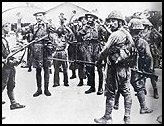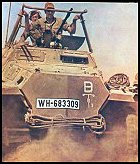
Japanese infantry herd captured British soldiers |
Remembering the First Fight Against Fascism |

German Panzergrenidiers on the move in North Africa |

Japanese infantry herd captured British soldiers |
Remembering the First Fight Against Fascism |

German Panzergrenidiers on the move in North Africa |
|
January 20 | January 21 | January 22 | January 23 | January 24 | January 25 | January 26 1941 Archives
Special Editions
Map Links:East Front Dec '41 - Feb '42 | North Africa Nov 41-July 43 | Japanese Expansion In the
Berlin suburb of Wanssee, a conference was held to determine the fate of
million’s of people. The Wannsee Conference was convened to discuss the
“Final Solution” to the Jewish Question. The chair of the committee was
none other than SS Obergruppenführer Reinhard Heydrich, a Nazi sociopath
second only to Hitler himself. At this meeting, the broad plan for the
execution of all Jews was finalized. In cold, calculated, and efficient
language these savages in uniform plotted the extermination of 11 million
soles. Wilhelm Stuckart, the lawyer who created the 1935 Nuremberg Laws
quietly and logically argued his case for determining how much “Jewish
blood was enough to taint German purity” when determining those with “mixed
blood” should be “sent east” (to the death camps). Of course, he indicated,
these “mixed bloods” would have to be sterilized.It
was also decided that “Final” solution would be to gas, rather than shoot,
starve, or otherwise kill the Jews would be the most efficient mechanism
to complete the task. Adolf Eichmann was given the task of executing these
protocols. Never in
the course of human history has such an atrocity been committed on the
face of this earth. A translation of the only surviving minutes to the
meeting can be found at … http://prorev.com/wannsee.htm Rommel,
after a retreat of 500 miles and only a few days to regroup his shattered
forces, launches a counter-offensive against the British in Libya. 21st
Panzer Division takes Mersa Brega and 15th Panzer moves east
beyond the British flank and then turns north toward Agebadia. The scattered
screening forces of the British 1st Armored Division are routed. London
and the southern ports of England are once again subjected to attacks by
the Luftwaffe as the Germans open a series of new raids. Japanese
aircraft hit allied positions in New Guinea for the first time in the war. Rommel’s
forces, now designated the Panzer Army Africa, capture Agedabia and trap
elements of the British 1st Armored division in the Antelat-Sannu
area. The British loses are heavy. Constant
pressure and mounting casualties forces MacAurthur to withdraw his Bataan
forces to the Mauban-Abucay line along the Pilar-Bagac road. This is the
last practical defense line available to the doomed defenders. During the
night the Japanese land forces at Quinauan and Longoskawayan Points, deep
in the US/Filipino rear. Allied reserves are able to contain the Japanese
beacheheads. Japanese
forces make landings at Rabaul (New Britian), Kavieng (New Ireland), Kendari
(Celebes) and at Bouganinville Island (Solomons). Rommel’s
Italian allies refuse to advance further to the east. Rommel, decides to
continue the attack with the Germans only. At Novi
Sad on the Danube River in Hungary, local soldiers marched 550 Jews and
292 Serbs onto the ice of the river and began shelling the location. The
ice broke and the captives froze and drown in the icy waters. The Special
Court of Inquiry into the Pearl Harbor disaster, headed by Justice Roberts
is submitted. The conclusion of the commission was that Admiral Kimmel
and General Short, the local Navy and Army commanders at Pearl Harbor neglected
to coordinate security precautions and were largely responsible for the
events of December 7. The report did not adequately address the failure
of Washington intelligence groups in the fiasco. Editor’s Note: It is
interesting that in six weeks, FDR’s administration was able to assess
this disaster, while the current occupant of the Whitehouse has yet to
even start an inquiry into the 9-11 tragedy after nearly four months. German
troops begin to regroup and attack in the Moscow area. Sukhinichi, a town
near Kaluga, is recaptured by the Germans. The Commonwealth
defenses in Singapore are reinforced by the arrival of the British 18th
Division. Japanese
forces land at Blikpapan in Dutch Borneo. German
forces advancing across the open desert threaten to cut off the 4th
Indian Division in the Behghazi area. The
6000 Japanese troops take Rabul on the island of New Britain. Most of the
1000 Australian defenders were killed after they had surrendered.
Those wishing to contribute items. stories or comments should contact D.A. Friedrichs |
The items
found in this section are comments from the editors of Project 60 and may
not necessarily reflect the opinions of bartcop.
Vietnam
and Afghanistan When the
“war against terrorism” began, many knowledgeable people warned that our
operations in Afghanistan would turn into another Vietnam. In the flush
of “victory”, much of the gloomy projections have been relegated to the
trash heap. However,
there are still some interesting comparisons that can be made. In the
early days of Vietnam, the United States inserted teams of Special Forces,
to assist in establishing good relations with the locals by helping with
village defense, health, and education programs. These operations were
highly successful in combating the influence of the Viet Cong. In the Afghan
war, a similar, and, like its predecessor, highly successful program is
well underway. Like Vietnam,
we are currently destroying any good will we have with the locals by blowing
stuff up. The old saying “we had to destroy the village in order to save
it” is alive and well and making a comeback in Afghanistan. However, we
have progressed a long way in 35 years. In Vietnam, we would send an infantry
platoon with Zippos into a village and burn it down. In Afghanistan, the
mud doesn’t burn, so we use precision-guided ordnance to turn peoples homes
into craters. The downside of this “improved” system, is that by the time
we get around to blowing up a house, a wedding party moves in and we blow
up a few score party-goers like we did at Qalaye
Niazi. The
biggest similarity between the two wars is the Pentagon briefings. The
goals and objectives are different but the level of lies and deceits have
not changed one bit. In Vietnam, the goal was to show progress by inflating
“body counts”. In our new, more compassionate world, we measure progress
by how many buildings we blow up in a sterile and non-violent manner, with
“minimal collateral damage”.In Vietnam
villages were called Viet Cong strongholds and in Afghanistan they are
called Al Qaeda compounds. In reality, these are places which were filled
with people, who wanted nothing more to try to scratch out a life for themselves
before we came and destroyed everything in their pitiful lives. The one
area that is glaringly different is how the US press is conducting operations
in the two wars. In Vietnam, the horrors and violence of war were brought
home. We saw that people, our soldiers, their soldiers, innocent people,
were horribly maimed and killed in war. Since Desert Storm, war for our
citizens has been converted into some sort of sick bloodless video game.
Our press today call sitting in a pentagon briefing journalism and don’t
bother to fact check the lies they are fed by the Administration. The India
Times has better, more accurate and more complete war coverage than the
New York Times. This is a sad and pathetic commentary on the health of
our Fourth Estate. Like Vietnam,
one of the reasons we got involved in the first place was to prop up a
corrupt and inept government, which we installed. In Afghanistan, we have
installed a government, but it remains to be seen just how corrupt and
inept it will be. Early signs, despite what is reported in the US media,
are not particularly encouraging. In Vietnam,
the primary reason for our presence was to stop Communism. In Afghanistan,
we have traded the bogyman of Communism for terrorism. Both were and are
vile and, if you will, evil. However, neither will be defeated by military
intervention. Economic stability, justice and self-determination are the
keys to defeating both of those enemies. In both
Vietnam and Afghanistan, the more compelling, and less acknowledged, reason
for intervention appears to be US business interests. In the 60’s it was
rubber and oil. Now it’s just oil and not even really oil, just a place
to put a pipeline that the Ruskies don’t control.
We seem to have an annoying habit of trading red blood for black gold. Previous Columns Want to Win - Think Before You Lash Out - "If we are serious about taking the war to the enemy, it is time to look ..." The First Fight Against Fascism - We must remember the Spanish Civil War also. Arguing Victory - "... Each nation who fought against fascist tyranny in WWII brought with it part of whole needed to defeat that evil..." War, Glory, Honor and Remembrance - "War is a brutal and savage insult on human society..." The
First Casualty... in time of war, those in power are even more
inclined to hide the truth, since that truth is often manifest in the most
gruesome and terrible acts. |